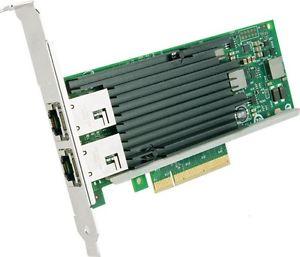- Related articles
- All Cisco DWDM-X2-36.61's information (List price, Specs, Datasheet PDF, Compatibility mat
- All Cisco MGBLX1's information (List price, Specs, Datasheet PDF, Compatibility matrix)
- All Cisco ONS-SI-GE-ZX's information (List price, Specs, Datasheet PDF, Compatibility matr
- Optical Transceivers for Cisco WS-CBS3125X-S Switch
- EoS and EoL Cisco 2960-S Series and 2960-SF Series Switches
- All Cisco DWDM-XENPAK-51.72's information (List price, Specs, Datasheet PDF, Compatibility
- Applicable to 40GBASE-PLRL4 Standard Optical Transceiver Models
- What is XFP transceiver?
- Optical Transceivers for Cisco N3K-C3064TQ-10GT Switch
- Optical Transceivers for Cisco N5K-C5020P-B-S Switch

Network interface card referred to as network card (NIC). It is an indispensable basic device in a computer network that provides physical connectivity for data communication between computers. Each computer must be installed once the network access network card. After many years of development, NIC has become mature. In view of so many types of NIC on the current market, and there are large differences in performance, so it is necessary to classify them in order to better understand the NIC.
Whereas network controllers used to operate on expansion cards that plugged into a computer bus, the low cost and ubiquity of the Ethernet standard means that most new computers have a network interface built into the motherboard. Newer server motherboards may even have dual network interfaces built-in. The Ethernet capabilities are either integrated into the motherboard chipset or implemented via a low-cost dedicated Ethernet chip, connected through the PCI (or the newer PCI Express) bus. A separate network card is not required unless additional interfaces are needed or some other type of network is used.

Dual Port Network Card
Dual Port Network Card can be a great help to maximize your servers. Dual Port Network Card eliminates one intermediate device, so that latency can be saved. Make sure you check your motherboard's documentation since there may be "hidden" switches on the motherboard that are increasing the slot density. Putting a quad into a switched port on a motherboard, especially one off of the IOH or ICH will really be worse case for latency. If you are latency sensitive, try to put duals into those switched slots.
What Is PCIE Wireless Network Card?
PCIE Wireless Network Cards fit inside a computer (PC / notebook / Laptop) and connect using the PCI, PCIe, M.2, Mini-PCIe interface. These Wireless Adaptors allow the computer to connect to a wireless network without having to run a network cable to the system. Advanced features such as high bandwidth and encryption ensure both a fast and secure connection to a WiFi network. Always check your motherboards interface for PCI or PCIe to ensure you select the correct wireless network card adaptor for your requirements.
Summary
Ethernet ports are force multipliers. With a single computer you can do neat things, but with a network, one plus one is more than two. When you get to hundreds of computers you get amazing things, and when you have millions of computers you get magic. The magic wouldn’t happen if every system had just one port, the number of clients would require equal number servers. This is where dual port network card help you.





































































